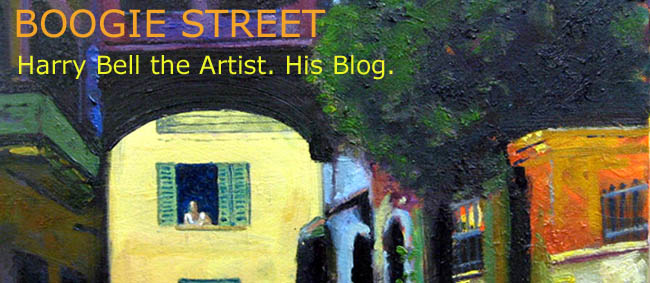This is not new and isn't confined to painting. Even when I was cartooning, I'd find myself being sucked into what I think of as "nuts and bolts" drawing, where I'd quite literally end up drawing every rivet in a machine, every stitch on a leather belt. Sometimes this can work, but I have to say that I prefer a more broad approach. It's the way I'm made.
In her excellent book, The Creative Habit, Twyla Tharp explores the difference in viewing things in detail and from afar.
The photographer Ansel Adams, whose black-and-white panoramas of the unspoiled American West became the established notion of how to "see" nature ... is an example of an artist who was compelled to view the world from a great distance. He found solace in lugging his heavy camera on long treks into the wilderness or to a mountaintop so he could have the widest view of land and sky.
She contrasts this with the work of Raymond Chandler:
The plots of his stories are often incomprehensible ... but his eye for descriptive detail was razor-sharp.Tharp suggests that these two ways of looking at things indicate the difference between involvement and detachment, and she finds that her own choreography is constantly being pulled by these opposing forces. She explores the tiny detail of a dance piece; then, when she understands how it's made, she pulls back and views it as if she were the audience. But she finds that, while she is interested in producing dance pieces which tell a story and invoke the detail of people's lives, she finds that harder than a work about broader more abstract subjects, like life force.
Chandler kept lists of observed details from his life and from the people he knew: a necktie file, a shirt file, a list of one-liners he intended to use sometime in the future.
Up close was Chandler's focal length. If some people like to wander through an art museum standing back from the paintings, taking in the effect the artist was trying to achieve, while others need to a closer look because they're interested in the details, then Chandler was the kind of museum-goer who pressed his nose up to the canvas to see how the artist applied his strokes.
I'm in danger of losing myself in this, but what I think I'm trying to say is that although I am interested in the detail of life, I tend to make my images from a distant, slightly detached point of view. And they're meant to be seen from a distance, but if, like Chandler, you'd care to get your nose up close to the canvas, I hope you'd find the abstract quality of the marks interesting, because there likely won't be any bricks to count, grass stems to admire, or stitches on a leather belt to savour.

Pillbox (2nd stage)
The painting of the coastal pillbox is following this approach. There is some apparent detailing of the concrete walls, but get up close and there's not really much to make out. And as for the grass, it's just areas of paint, dragged and scumbled over the initial pumice layer.














